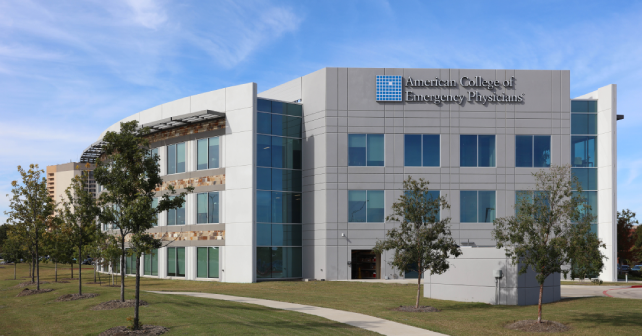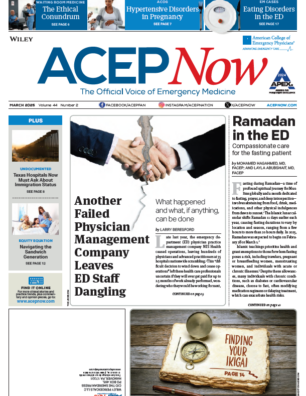
Alarms in the Emergency Department
Explore This Issue
ACEP Now: Vol 44 – No 02 – February 2025Research in the April 2025 issue of JACEP Open, the official ACEP open access peer-reviewed journal, looks at alarms in the emergency department and their impact on clinicians.
Authors Sebastian Johansson, MSc; Erika Johannesson, MSc; Erika Hörlin, MSc; and Jens Wretborn, PhD, report that 396,011 alarms were registered during the data collection period, or one alarm every 30 seconds in the urban and academic centers and every 120 seconds in the rural hospital, on average. Median confirmation times were 11 seconds for high severity alarms (IQR, 5-33) and 132 seconds for low severity alarms (IQR, 15-878).
Technical devices are used for the continuous monitoring of patients’ vital signs (saturation, heart rate, heart rhythm, blood pressure, and respiratory rate) in modern health care systems. “Alarm Fatigue in the Emergency Department: A Multicenter, Mixed-Method Study of Monitor Alarms” explains that monitoring enables early detection of patient deterioration and the possibility for health care staff to oversee multiple patients at the same time. “However, the monitors have been shown to cause large volumes of alarms that rarely lead to an intervention. The high volume of alarms affects the workplace environment and may cause alarm fatigue when staff become tired and desensitized to alarms.”
This poses a threat to patient care, and the Joint Commission has declared alarms from patient monitoring devices a focus area to improve patient safety, the research states.
The article points out that “ED staff work in an alarm environment prone to alarm fatigue with frequent alarms and several system-related factors that increase the risk of alarm fatigue, which is mitigated by the individual health care worker.”
Briefly
Join ACEP Council Speaker Melissa W. Costello, MD, FACEP, and ACEP Council Vice Speaker Michael J. McCrea, MD, FACEP, next month to learn about how the ACEP Council works and how even a single member can make a big impact on the policy and direction of the College. The ACEP Council is a deliberative body that meets once a year for two days in conjunction with the College’s annual Scientific Assembly. The Council votes on resolutions that guide the activities of the College. Learn how to craft your resolution and weigh in on the pressing issues in emergency medicine. This free virtual event is set for 2 p.m. (CST) on Thursday, April 10.
Registration is open for ACEP’s Leadership and Advocacy Conference. Both chambers are expected to be in session April 27-29 when ACEP members and volunteers learn crucial leadership skills and advocate for the specialty. Don’t miss your chance to make a positive impact on your practice and your patients.
Enjoy the latest Frontline Podcast on video. Recorded at ACEP’s Accelerate conference in Orlando last month, host Dr. Ryan Stanton and guest Dr. Keri Gardner discuss malpractice litigation. They touch on the emotional toll of malpractice lawsuits on emergency physicians and share strategies for navigating legal stress and mitigating risk. Watch their conversation on YouTube
Alternate Residency Application Platform Being Considered
In October during ACEP’s Scientific Assembly in Las Vegas, the Council of Residency Directors in Emergency Medicine (CORD-EM) held a town hall meeting and offered information about plans to consider alternatives to ERAS.
In a statement issued after the meeting, CORD-EM wrote that it had “partnered with ResidencyCAS to help us develop our own platform specifically designed to support our emergency medicine residency application process. This custom-built platform will streamline the entire application process for students, Program Directors, and Program Coordinators, while also reducing administrative and financial burdens, and will ultimately enhance the experience for everyone.”
An article in the March 2025 issue of Annals of Emergency Medicine by journalist Monique Brouillette offers an update into the process.
That article was released digitally on Feb. 19 and includes historical background on ERAS, a look at other specialties who made a switch from ERSA, and interviews with the AAMC, emergency physicians, and program directors. The article also looks at the possible replacement of ERAS – ResidencyCAS.
ResidencyCAS offers smartphone applications and AI capabilities and charges lower fees to applicants, the article states. The writer says that “under the current ERAS fee schedule, applicants spend roughly $810, considering an average of 46 applications. ResidencyCAS is less expensive, costing $683 for the same number of applications. These savings approximately parallel those of an ERAS alternative offered to plastic surgery residency applicants, an application called the Plastic Surgery Central App. In one estimate, plastic surgery applicants saved $129 during the application cycle.”
Liza Smith, MD, Associate Professor of Emergency Medicine at UMass Chan Medical School and co-chair of the Application Process Improvement Committee (APIC) at CORD-EM, told Ms. Brouillette that emergency medicine leaders in the residency space will build the application with ResidencyCAS. They will conduct focus groups and webinars to gather community input while incorporating holistic review tools and interview scheduling capabilities. Smith said that they would also communicate with the AAMC to explore their future directions and improvements.
ACEP Calls for Administration to Ensure Robust Federal Health Infrastructure
ACEP issued a statement last week on behalf of 40,000 emergency physician members who care for those in our country during their times of deepest need.
ACEP respectfully called on the Administration to recognize the critical importance of a robust federal health infrastructure in safeguarding the prosperity and security of our nation, and the health and well-being of our people.
Emergency physicians proudly serve as the country’s safety net, providing high-quality care to more than 150 million patients annually. This safety net is reinforced in large part by the work of numerous federal agencies. For example, the Administration for Strategic Preparedness and Response (ASPR) enhances our readiness to respond to disasters, mass casualty events, and national security threats, such as bioterrorism, chemical, or even nuclear attacks. The Centers for Medicare and Medicaid Services (CMS) provides vital data, payment frameworks, and resources that are mission-critical to caring for all Americans, particularly rural populations and especially our seniors who have earned and deserve the promise of the Medicare program.
Journal Research Looks at Physician Coverage in the ED
A new study published in JACEP Open, one of ACEP’s peer-reviewed publications, asked the question, “Is at least one attending physician (not resident) on duty in the ED 24 h/d?”
The research found that approximately 1 in 13 EDs in the U.S. lack 24 hour, seven-day-per-week physician coverage. The absence of 24/7 attending physician coverage was more common in low-volume EDs and CAHs. Unsurprisingly, the states with the least coverage included those of the Great American West – Montana, North Dakota, and South Dakota. Critical gaps in coverage, largely exacerbated by regional maldistribution of physicians demonstrates the nation’s fallibility in acute, unscheduled care.
ACEP Now recently explored the idea of having an emergency physician in every ER, and prior articles discussed issues with growing the emergency medicine workforce in this region of the country. These observations highlight important gaps in ED care nationally.
Results from the research came from the National ED Inventory (NEDI)-USA survey, sent annually to the ED director of every nonfederal US ED. The 2022 survey (administered in 2023 to all EDs open during 2022) included the physician question. The NEDI-USA database includes basic ED characteristics such as annual visit volume, critical access hospital (CAH) status, rural location, and freestanding ED status.
The 2022 NEDI-USA database identified 5622 EDs, of which 4621 (82%) responded to the 24/7 attending physician question.
Pages: 1 2 3 4 | Multi-Page




No Responses to “February 2025 News from the College”